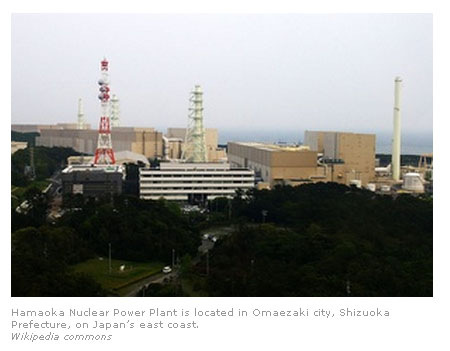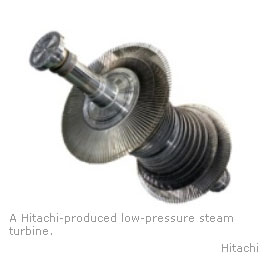COMMENT: Hit by a $1 billion liability verdict in Japan, Hitachi negotiates new reactor deal with Lithuania
October 17, 2011
Andrei Ozharovsky
Translated by Maria Kaminskaya
Bellona
A court in Tokyo has ruled Japan’s Hitachi liable for over $1 billion in damages resulting from an accident, and subsequent loss of profit, at Hamaoka Nuclear Power Plant’s (NPP) Hitachi-made ABWR reactor. Boiling reactors, to which the ABWR series belongs, have earned their share of infamy with Chernobyl’s explosion and the disaster at Fukushima– but they have also proven challenging both in operation and repairs. Still, Hitachi continues to promote ABWRs for export construction, including in Lithuania, where it hopes to build a new station to replace the shut-down Ignalina

Over a billion dollars for forced downtime
On October 6, 2011, the District Court of Tokyo issued a verdict that wrapped up a three-year-long litigation over the protracted repairs and resulting outage following an accident at Reactor Unit 5 of Japan’s Hamaoka Nuclear Power Plant, in Omaezaki city, Shizuoka Prefecture.
The court ruled the Japanese electronics and heavy industry giant Hitachi, which manufactured the turbine used at the plant, liable for paying Hamaoka’s operator entity, Chubu Electric Power Company, JPY 90 billion (or $1.17 billion) in compensation for the loss of profit that resulted from the downtime.
Because of problems with the Hitachi-made steam turbine, the reactor at Hamaoka remained in repairs for nearly eight months, since June 2006 to February 2007. The operator company brought a lawsuit in 2008 and the Tokyo District Court has now ruled in its favour.
Even though the steam turbine has been repaired, the plant will likely be completely decommissioned. Last May, according to a story by the BBC, Japan’s Prime Minister Naoto Kan asked Chubu to halt operations at the plant for fears of a repeat disaster of the Fukushima scenario. Extreme efforts to bring under control the nuclear and radiation catastrophe at Fukushima – which last March had been hit by the dual force of an earthquake and an estimated 15-metre tsunami wave, knocking that plant’s power supply and leading to multiple meltdowns and massive releases of radiation – had still been in progress at the time, and are ongoing now.
Hamaoka, located 200 kilometres southwest of Tokyo, is, too, in a seismic-prone area. According to an article by Bloomberg from last May, Kan "[cited] a government study that showed an 87-percent likelihood of a magnitude-8 quake striking the area within 30 years." Chubu Electric agreed to shut Hamaoka’s reactors down.
In Russia, equipment failures at nuclear power plants are not so infrequent and also lead to losses incurred to the operator company. The Russian Federal Service for Ecological, Industrial, and Atomic Supervision, or Rostekhnadzor, says the many disturbances or violations it registers in its yearly reports as occurrences disrupting the operation of Russian NPPs are the result of "such underlying causes as mismanagement, flaws in maintenance organisation, manufacturing defects, and design defects."
Each time a reactor undergoes unplanned repairs owing to an electrical or other equipment failure that results in an emergency shutdown, the nuclear power plant necessarily undersupplies electric power to consumers. Still, lawsuits such as the one heard in Tokyo are unlikely to happen in Russia since the entire industry – from the equipment suppliers to the NPP construction companies to the operator company – remains within the corporate umbrella of the State Nuclear Corporation Rosatom, with all potential disputes settled internally. Because the state is the corporation’s shareholder, all financial losses and costs incurred by emergency repairs are covered with funds provided from the federal budget.
The accident with the turbine
 Reactor Unit 5 at Hamaoka was commissioned in January 2005 and was the only one running a reactor of the ABWR type, which stands for Advanced Boiling Water Reactor, a Generation III boiling water reactor (BWR). The other four units at the plant operated BWRs.
Reactor Unit 5 at Hamaoka was commissioned in January 2005 and was the only one running a reactor of the ABWR type, which stands for Advanced Boiling Water Reactor, a Generation III boiling water reactor (BWR). The other four units at the plant operated BWRs.
The design, certified in 1997 by the US Nuclear Regulatory Commission, was developed by GE Hitachi Nuclear Energy, an alliance between General Electric and Hitachi. The plant is designed to produce electricity from a turbine generator unit using steam generated in the reactor, says a design description on the International Atomic Energy Agency website.
The accident at Unit 5 happened just eighteen months after the reactor launch. Reports say that in June 2006, turbulence occurred in the stream of radioactive steam flowing from the reactor into the turbine. That, combined with a high-velocity backflow of steam, caused strong vibrations in the turbine.
Of the 840 turbine blades, 622 were damaged as a result. Cracks appeared both in the blades and where they were joined to the turbine rotor. The accident also caused one of the blades to lose a fragment, which led to even more extensive damage.
The single 1,380-megawatt turbine used at the unit proved challenging to repair both on account of the scope of the damage incurred and because of the peculiarities of the ABWR design.
The ABWR is a single-loop reactor. Water is taken to a boil in the reactor vessel and the generated steam flows into the turbine to spin its blades and produce electric power. This approach – which replaced a two-loop system with a steam generator – was opted for in order to simplify the design and cut on operation costs.
In practical experience, however, boiling reactors proved difficult to repair. In a two-loop design, radioactive substances do not reach the turbine and it remains uncontaminated, so should it need repairs, no additional challenge is there to complicate the works.
However, nuclear power plants that use boiling reactors such as the Soviet-designed RBMK series (of which the RBMK-1000 model was used at Ukraine’s Chernobyl, and three Russian nuclear power plants continue to operate the same design) and the US-Japanese BWRs and ABWRs have to contend with turbines that get contaminated with radionuclides in the course of operation.
Special precaution is thus called for when repairing the turbine following a malfunction. Furthermore, the repair itself cannot be started immediately after an accident as a waiting period is needed until radioactivity levels, caused by the short-lived radionuclides in the steam, subside sufficiently to ensure safety.
Exploding reactors and imploding profits
Boiling reactors have not exactly shown a stellar record. It was a graphite-moderated boiling reactor, of the RBMK-1000 model, that exploded in Chernobyl in 1986.
And at Fukushima, even though it was the fatal loss of cooling at the plant, caused by the natural disaster, that was to propel the accident to catastrophic levels, the General Electric Mark I boiling-water reactors were not completely without blame either: The reactors shut down duly when the earthquake hit, but, said several engineers involved with the design of the Mark I model in interviews following the disaster, the reactors’ containment vessels were too small to insure against dramatic build-ups of hydrogen, which led to explosions at Units 1, 2, and 3 at the plant and subsequent damage to the reactor vessels.
Hydrogen venting systems on the reactors also failed, and had to be opened manually, causing critical delays that led up to the hydrogen pressure explosions.
Three engineers with GE who had reviewed the Mark I design in 1975 resigned over these flaws when the company insisted on bringing the reactor to market.
Reactors of the ABWR series have been online since 1996, but their reliability record is not the most reassuring. At some, over 50 percent of overall operation time is spent in outage, repairs, or maintenance. That necessarily affects the bottom line.
For example, in the entire period that Unit 5 was in operation at Hamaoka, it was only producing electricity 46.7 percent of the time.
At Shika, a nuclear power plant in the town of Shika, Ishikawa, where a Hitachi-made ABWR has been in operation at Unit 2 since being commissioned in March 2006, that figure is 47.1 percent.
With a $1 billion blow to its pocket, Hitachi tries peddling its reactors in Lithuania
Hitachi continues its efforts to export the ABWRs, a brainchild of the 1990s, abroad.
One market it has been viewing for export reactor construction is the former Soviet republic of Lithuania, where the old, USSR-built Ignalina Nuclear Power Plant in the town of Visaginas was shut down to comply with the European Union’s membership requirements.
But ever since closing down the old station, which operated two Soviet RBMK-1500 models, Vilnius has been searching for an investor to replace the defunct capacity with a new plant.
Throughout 2009, Lithuania was seen pursuing negotiations over the new nuclear power plant project in Visaginas, with Prime Minister Andrius Kubilius indicating in June that year that a new nuclear reactor serving all three Baltic states – Latvia, Lithuania, and Estonia – as well as Poland, could be completed by 2018.
In May 2009, AFP reported that Canada was pitching a CANDU reactor to Lithuania. By then Lithuania’s government had already talked with such reactor manufacturers as the French Areva, Spanish Endesa, General Electric-Hitachi and Westinghouse from the US, the British Nukem, and Japan’s Mitsubishi Heavy Industries.
With many factors complicating Lithuania’s new nuclear push – such as, for one, the rival efforts from Belarus, which is bent on building a nuclear power plant in its Ostrovets, close to the Lithuanian border, or from Russia’s Rosatom, with its own project in the Russian westernmost enclave of Kaliningrad, also on the border with Lithuania – the search for an investor and construction partner has not been easy.
But recently, Lithuania announced it found one in Hitachi.
Having apparently hitched his political future to the nuclear wagon, Premier Kubilius now seems willing to give the reins to a reactor construction project to a company that is now grappling with a $1 billion liability payment for a faulty turbine in Japan.
Media reports cite Kubilius as saying that concession agreements on the construction of the new NPP in Visaginas could be reached before the end of the year.
Hitachi is understandably interested in pushing a reactor on a less than favourable post-Fukushima market. New contracts are hard to come by, and previously signed deals are under threat of being called off by the increasingly reluctant customers. As an example, the deal for an ABWR reactor pitched for the South Texas Project in the US fell through in March 2011.
There are also rumours that some of the equipment Hitachi has already manufactured to deploy at that site will now be sent to Lithuania.
Meanwhile, the public may not be all too happy about the prospects of Hitachi coming to Lithuania with a new reactor. Ecological organisations continue to protest both the new project in Visaginas and those pushed for by Russia and Belarus.
Fearing that the three new stations will ensnare the region into a dangerous nuclear noose, environmentalists are collecting signatures calling for a nuclear-free status, and a parliamentary commission in Vilnius has also been gathered to look into the issue of whether the decision to build a new plant in Lithuania has sufficient merit to proceed with the plans.
This document contains copyrighted material whose use has not been specifically authorized by the copyright owner. SEED Coalition is making this article available in our efforts to advance understanding of ecological sustainability, human rights, economic democracy and social justice issues. We believe that this constitutes a "fair use" of the copyrighted material as provided for in section 107 of the US Copyright Law. If you wish to use this copyrighted material for purposes of your own that go beyond "fair use", you must obtain permission from the copyright owner.


